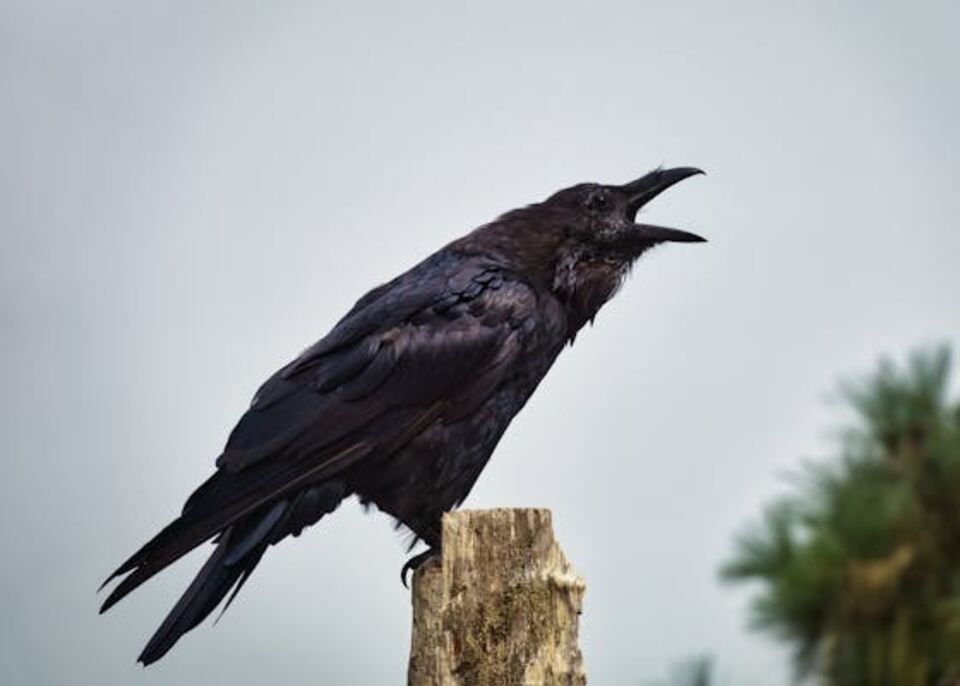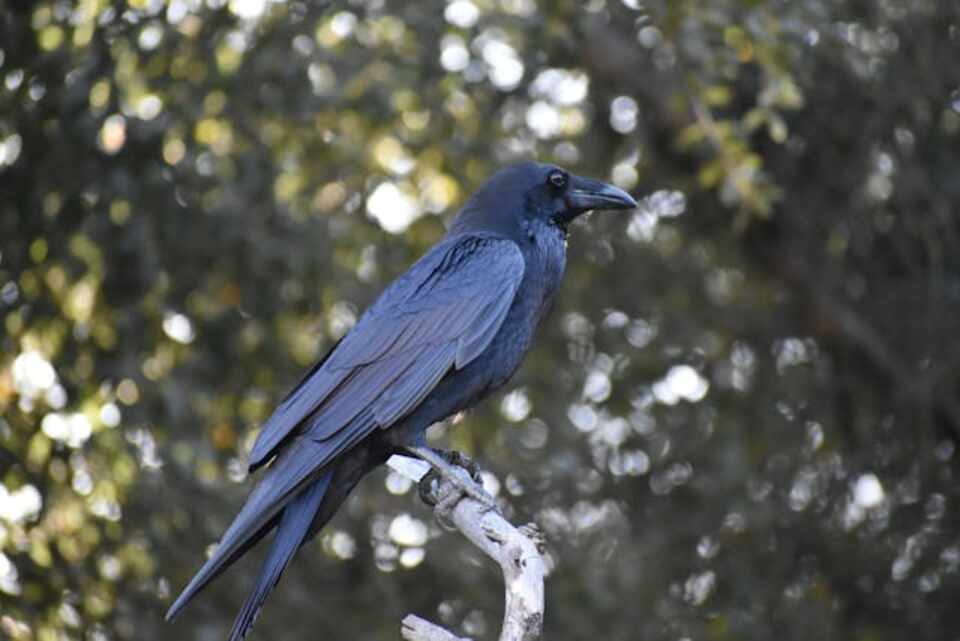Ever wondered, how to attract ravens to your yard? The answer is simple. Ravens are intelligent birds that are drawn to open spaces, tall trees for perching, and consistent food sources like nuts, fruit, and meat scraps. They also return to places they feel safe and familiar with. In this article, you will learn how to create the kind of environment that encourages ravens to visit and stay around your yard.
Table of Contents
Understanding Ravens
Before diving into the specifics of attracting ravens, it’s crucial to understand these magnificent birds. This knowledge will help you create an environment that truly caters to their needs and preferences.
What Are Ravens?
Ravens (Corvus corax) are large, black birds belonging to the corvid family, which also includes crows, jays, and magpies. Often confused with crows, ravens are larger, with a more robust beak, shaggy throat feathers, and a wedge-shaped tail in flight.
Raven Behavior and Intelligence
Ravens are renowned for their intelligence, often compared to that of great apes and dolphins. They exhibit complex problem-solving skills, use tools, and have demonstrated the ability to plan for the future. In social settings, ravens form strong bonds, engage in play, and even hold “funerals” for their deceased.
Habitat and Range
Ravens are adaptable birds found across a wide range of habitats, including forests, mountains, deserts, and even urban areas. They’re native to much of the Northern Hemisphere, including North America, Europe, Asia, and North Africa.
Creating the Right Environment
To attract ravens to your yard, you need to create an environment that meets their needs and preferences. Here are some key factors to consider:
Landscape Features
Ravens prefer areas with a mix of open spaces and trees. Consider the following landscape elements:
- Trees: Tall trees provide perching and potential nesting sites.
- Open Areas: Clear spaces allow ravens to forage and observe their surroundings.
- Varied Terrain: A mix of hills, rocks, and flat areas can make your yard more appealing.
Natural Elements
Incorporate natural elements that ravens find attractive:
- Rocks and Boulders: These provide perching spots and potential caching locations.
- Dead Wood: Logs or stumps can attract insects, a food source for ravens.
- Native Plants: Use plants native to your area to create a more natural environment.
Minimizing Disturbances
Ravens can be wary of human activity. To make your yard more inviting:
- Reduce noise pollution
- Limit artificial lighting at night
- Create secluded areas away from high-traffic zones
Food and Feeding Strategies
One of the most effective ways to attract ravens is by providing food. However, it’s important to do this responsibly and in a way that mimics their natural foraging habits.
Types of Food Ravens Enjoy
Ravens are omnivores and opportunistic feeders. They enjoy a varied diet, including:
| Food Category | Examples |
|---|---|
| Meat | Raw or cooked meat scraps, eggs, fish |
| Insects | Mealworms, crickets, grubs |
| Fruits | Berries, apples, grapes |
| Nuts | Peanuts, walnuts, almonds |
| Seeds | Sunflower seeds, pumpkin seeds |
| Grains | Corn, wheat, oats |
Feeding Techniques
To attract ravens while maintaining their natural behaviors:
- Scatter Feeding: Spread food over a large area rather than in a single pile.
- Irregular Feeding: Vary the times and amounts you put out food.
- Food Puzzles: Create simple puzzles or obstacles that ravens need to solve to access food.
- Mimic Carrion: Occasionally offer larger pieces of meat to simulate their natural diet.
Feeding Stations
While ravens aren’t typical backyard feeder birds, you can set up feeding stations that cater to their preferences:
- Platform Feeders: Large, open platform feeders allow ravens to land and eat comfortably.
- Ground Feeding Areas: Designate a space on the ground for scattering food.
- Hanging Food Items: Suspend large pieces of food from tree branches to encourage natural foraging behaviors.
Water Sources
Like all birds, ravens need access to fresh water for drinking and bathing. Providing water sources can make your yard more attractive to these intelligent birds.
Types of Water Features
Consider installing one or more of the following:
- Bird Baths: Large, sturdy bird baths with shallow water are ideal.
- Moving Water: Ravens are attracted to the sound of running water. Consider a small fountain or dripper.
- Natural Water Sources: If possible, create a small pond or stream in your yard.
Maintaining Water Sources
To keep your water features safe and attractive for ravens:
- Clean and refill water sources regularly
- Ensure the water is no more than 2-3 inches deep
- Place water features near trees or shrubs for safety
- In winter, use a bird bath heater to prevent freezing
Nesting and Shelter
While ravens typically nest in more remote areas, providing potential nesting sites and shelter can make your yard more appealing.
Nesting Sites
Ravens prefer to nest in tall trees or on cliff ledges. While you can’t recreate cliff faces, you can:
- Preserve large, mature trees in your yard
- Install sturdy platforms high in trees (at least 20 feet up)
- Maintain dead trees (if safe) as potential nesting sites
Shelter
Provide areas where ravens can seek refuge from harsh weather or predators:
- Dense evergreen trees or shrubs
- Natural or artificial caves or overhangs
- Brush piles in quiet corners of your yard
Safety Considerations
Creating a safe environment is crucial for attracting and protecting ravens.
Reducing Hazards
Eliminate common dangers in your yard:
- Remove toxic plants that could harm ravens
- Secure trash cans to prevent accidental poisoning
- Avoid using pesticides or herbicides
Protection from Predators
While adult ravens have few natural predators, they still appreciate safe spaces:
- Provide escape routes and cover near feeding areas
- Keep domestic pets indoors or supervised when ravens are present
- Install thorny shrubs near potential nesting sites to deter climbing predators
Legal and Ethical Considerations
Before actively trying to attract ravens, it’s important to understand the legal and ethical implications.
Legal Status
In many countries, including the United States, ravens are protected under various wildlife laws:
- The Migratory Bird Treaty Act prohibits capturing, killing, or possessing ravens without a permit
- Local regulations may restrict feeding wild animals, including ravens
Always check your local laws before implementing any attraction strategies.
Ethical Considerations
Consider the following ethical points:
- Avoid creating dependency on human-provided food
- Maintain a balance between attracting ravens and supporting other local wildlife
- Be mindful of neighbors who may not appreciate increased raven activity
Maintaining a Raven-Friendly Yard
Once you’ve created an environment attractive to ravens, it’s important to maintain it properly.
Regular Maintenance
- Clean feeding areas and water sources regularly
- Trim trees and shrubs to maintain ideal perching and nesting spots
- Remove any accumulated waste or debris that could harm ravens
Seasonal Considerations
Adjust your raven-attraction strategies based on the season:
| Season | Considerations |
|---|---|
| Spring | Provide nesting materials (twigs, moss, animal fur) |
| Summer | Ensure ample water sources for hot days |
| Fall | Offer high-energy foods to help with migration or winter preparation |
| Winter | Maintain unfrozen water sources and increase food offerings |
Observing and Interacting with Ravens
Once ravens start visiting your yard, you’ll want to observe and potentially interact with them responsibly.
Observation Tips
- Use binoculars or a spotting scope for close-up views without disturbing the birds
- Keep a journal to record raven behaviors and patterns
- Set up a wildlife camera for round-the-clock observation
Responsible Interaction
While ravens are intelligent and may seem approachable, it’s important to maintain a respectful distance:
- Never attempt to touch or handle wild ravens
- Avoid making loud noises or sudden movements that could startle them
- Do not try to “tame” wild ravens or keep them as pets
Troubleshooting Common Issues
Even with the best preparation, you may encounter some challenges when attracting ravens.
Ravens Aren’t Coming
If you’re not seeing ravens despite your efforts:
- Be patient; it can take time for ravens to discover and trust a new food source
- Ensure you’re in an area within raven habitat range
- Increase the variety of foods offered
- Reduce human activity in the yard
Unwanted Wildlife
Your efforts to attract ravens may also draw in other wildlife:
- Use raven-specific feeding strategies that may be less attractive to other animals
- Install baffles or guards on feeders to deter squirrels and other climbing animals
- Remove food at night to discourage nocturnal scavengers
Neighbor Complaints
If neighbors express concern about increased raven activity:
- Educate them about the benefits of having ravens in the area (pest control, ecosystem balance)
- Adjust feeding times or locations to minimize impact on neighboring properties
- Ensure all attraction methods comply with local regulations
By following this comprehensive guide, you’ll be well-equipped to create a raven-friendly environment in your yard. Remember, attracting ravens requires patience, consistency, and a deep respect for these remarkable birds. As you embark on this rewarding journey, you’ll not only have the opportunity to observe these intelligent creatures up close, but also contribute to their conservation and well-being in your local ecosystem.






